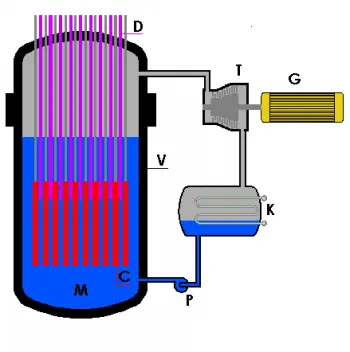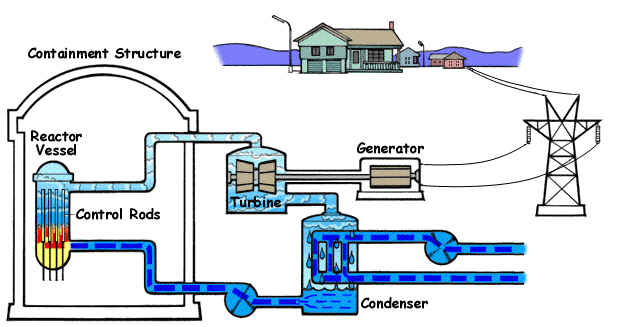
A boiling water reactor or BWR (boiling water reactor) is a type of nuclear reactor. It is the second most used type of reactor in nuclear power plants in the world.
Approximately 22% of the nuclear reactors installed in the different nuclear power plants use the BWR reactor.
The BWR is a power reactor; that is, it is designed to generate electrical power.
The most important feature of the Boiling Water Reactor (BWR) is that it uses light water (ordinary water) as a neutron moderator and a core coolant. Unlike the pressurized water reactor (PWR), it does not have a steam generator.
This type of light water reactor has a primary circuit and a secondary circuit. In this case, the BWR reactor operates with a single water circuit in the core.
As it does not have to withstand such high pressures, this type of reactor does not need such a robust casing.
The first BWR was an experimental reactor called Borax I, built by the Argonne National Laboratory and General Electric (GE) in Idaho, the United States, in 1952.
Scheme of the operation of a boiling water reactor
The boiling water reactor power generation starts in the reactor core. The reactor core generates nuclear fission reactions of the fuel element to obtain thermal energy in a heat generation process.

The reactor power is regulated by inserting or removing the control rods from the core, where nuclear chain reactions occur.
In the BWR reactor, the water used is light water (ordinary water). This type of nuclear reactor uses a single cooling circuit. In contrast, whit HWR and PHWR reactors, which are cooled and moderated by heavy water. Light water circulates through the nucleus, capturing the heat from nuclear reactions, it reaches the boiling temperature ang generates steam.
A neutron moderator is a medium that reduces the velocity of fast neutrons, thereby turning them into thermal neutrons—doing that, the probability that a fission reactor happens increases.
The steam produced in the reactor core goes out from the top. At this point, steam dryers separate water and treat the moisture leaving the reactor, and then it goes straight to the turbines.
The turbines will be in charge of running the electric generator and generating electricity.
Finally, the steam passes through a condenser to turn it into liquid water again and start the cycle again.
The boiling water reactor uses a single cooling circuit so that the steam that drives the turbine is made up of water passed through the inside of the reactor. For this reason, the turbine building must be protected to avoid radioactive emissions.
Some early BWRs and the proposed ESBWR designs use only natural circulation.
Boiling water reactor, advantages, and disadvantages
Benefits of this type of reactor
-
The nuclear fuel used by the atomic reactor is uranium oxides enriched between 2% and 4%.
-
The boiling water reactor does not use steam generators or pressure compensators.
-
The reactor’s first circuit operates at a pressure of 70 atmospheres against 160 atmospheres used by PWR reactors (pressurized water reactor).
-
It requires lower operating temperatures, even at fuel rods.
-
Due to the rejection of neutron absorption in boron and a slightly weaker neutron moderation (due to steam), the operating time of plutonium in such a reactor will be longer than in PWR.
-
The pressure vessel is subjected to less irradiation than in a pressurized water reactor. For this reason, the reactor vessel does not become so fragile with age.
Disadvantages of this type of reactor
-
It is not possible to recharging nuclear fuel without stopping the atomic reactor.
-
The management of the station is more complicated.
-
The control rods must be inserted from below. In case of a loss of power, they could not fall into the reactor by gravity, and the reactor would not stop.
-
Need for a more significant number of feedback sensors.
-
You need a reactor vessel of about two times more in volume than a PWR of comparable power.
-
Although designed for lower pressure, it is more challenging to manufacture and transport.
-
Turbine contamination with water activation products: short-lived N-17 and traces of tritium. It complicates maintenance work quite a bit.
-
Once the control bars have fully entered, the reaction is stopped. However, nuclear fuel continues to emit heat. It means that after the reactor is shut down, you have to keep pumping coolant for one to three years to be safe.
